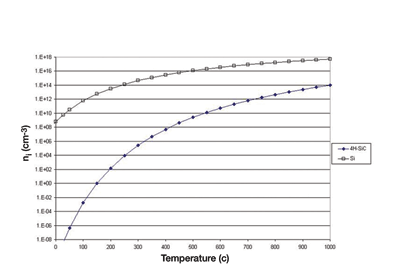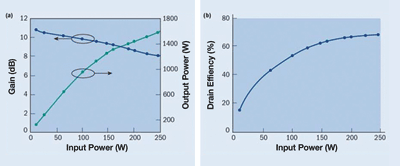Today’s apps in the VHF band to the S-band need SiC’s higher voltage, density
BY MIKE MALLINGER and MAR CABALLERO
Microsemi, Santa Clara, CA
http://www.microsemi.com
There are many options for developing RF transistors, including silicon bipolar junction transistors (BJT), laterally diffused metal oxide silicon (LDMOS), silicon metal oxide semiconductor field effect transistor (MOSFET), and gallium arsenide (GaAs) metal semiconductor field-effect transistor (MESFET) technology. These technologies have each been used extensively in apps ranging from pulsed avionics systems and military communications to EDGE and WCDMA amp apps. For challenging radar apps in the VHF band through the S-band, however, these options don’t deliver adequate key performance characteristics such as high power output and long pulse widths with low pulse droop, all due to limitations on breakdown voltages, power densities, and thermal conduction.
SiC vs Si
The biggest problem with using silicon BJT and LDMOS or GaAs technology in these radar applications is the lower operating voltages, which limit the peak powers at medium pulses (typically 300 W at 300 µs), which in turn narrows the radar’s operating range. These technologies simply can’t operate at voltages high enough to deliver long powerful pulses at a high duty factor as required for next-generation systems.
Because of these deficiencies, in the 1990s the DoD funded the development of silicon carbide (SiC) semiconductor materials technology, and now the radar system industry is turning to SiC to build high-performance transistors with peak output powers of 2.0 kW or more from a single device. SiC consists of silica sand and carbon combined at temperatures between 1,600 and 2,500C.
While SiC has been available since 1824, it has only been in the past decade that it has been used commercially in microelectronics and power electronics. SiC offers higher thermal conductivity, higher breakdown electric field, larger bandgap, and higher saturation velocity than silicon.
SiC performance
SiC’s excellent thermal performance and high breakdown voltages are both particularly important. SiC is called a “wide bandgap” material because of the energy gap between the conduction band minimum and the valence band maximum.
Because of the higher bandgap energy, SiC doesn’t reach intrinsic carrier concentration (the point at which a device begins to behave as a bulk resistor and fails to operate in normal semiconductor fashion), until temperatures exceed 1,000C (see Fig. 1 ). This means that SiC devices can function as good semiconductors in excess of 500C.
As for breakdown voltages, the electric field characteristics of SiCs allow them to handle an electric field 10 times greater than silicon before breakdown occurs (see Fig. 1 ). This enables the use of a thinner, more highly doped drift layer, resulting in a lower on-resistance typically a minimum of 10 times lower than for silicon devices of the same blocking voltage.

Fig. 1. Intrinsic carrier concentration (ηi) comparison between Si and SiC.
SiC can be used to develop several devices including Schottky barrier diodes (SBDs), PIN diodes, junction field-effect transistors (JFETs), MESFETs, bipolar junction transistors (BJTs), MOSFETs, and insulated gate bipolar transistors (IGBTs). As SiC Long Pulsed Radar transistor technology matures, it is expected that these SiC transistors will be able to deliver a peak output of 750 W, enabling pulse lengths of 1 ms or more for the next generation of long-range radar systems.
The devices will also be able to operate at higher temperatures than silicon devices, and their superior thermal conductivity will allow higher power densities (~ 2.5 times that of any silicon BJT or LDMOS) thereby resulting in a reduction in the transistor count and amplifier size / weight for a specific output power. The part count reduction will lead to a substantial increase in long-term reliability. The operation at higher voltage offers an additional benefit in the reduction of peak currents within the system.
A new generation of SiC static induction transistors (SITs) are designed to cover lower-frequency VHF and UHF radar bands allocated by the International Telecommunications Union (ITU). These bands, including the 138 to 160-MHz VHF and 420 to 450-MHz UHF bands, are typically used in applications including long-range search and air-route surveillance.
Among the first SIT devices for these applications are Microsemi’s 0150SC-1250M and 0405SC-1000M common-gate, class AB RF power transistors, which use SiC technology to offer the industry’s highest power output (1,400 W typ at VHF and 1,100 W at UHF of peak power) in compact single-ended packages. Typical silicon-based RF power transistor solutions offered throughout the industry must use complex push-pull designs to achieve similar power levels.
Examples
Devices like the 0150SC-1250M and 0405SC-1000M SITs are manufactured in a compact 1.5-mm-square chip, which is significantly smaller than silicon BJT or LDMOS alternatives. Microsemi’s full 1000 W, 0405SC-1000M SIT has seven chips wired into the package. Each chip has five active areas, known as cells.
The final transistor uses 32 cells that can each produce a peak output of 45 W and 36 W at VHF (156 MHz) and UHF (450 MHz) frequencies, respectively. Dividing the chips into multiple active areas improves transistor performance by enabling low-inductance connections and good thermal distribution. This improves operation at higher frequencies. As the frequency is increased, the active cell size gets smaller, and more cells are employed on a chip.
Microsemi tests its SITs at a 10% duty cycle using medium and long pulses with widths of 300 µs and 1 ms (see Fig. 2 ), and has also tested them under extended pulse width and duty factor. The extended test results show considerably greater headroom for higher-voltage operation. As an example, SITs that run at 100 V and have been adjusted to operate at 200 MHz have been shown to produce 800 W from 1.8-ms pulses and an 18% duty cycle more than triple the performance of the best silicon products.

Fig. 2. Chart a shows power delivery of more than 1.5 kW at 156 MHz for Microsemi’s transistors, using 300 µs pulses and a 10% duty cycle. Chart b shows drain efficiency of nearly 70% at this output power.
Tests also show that when SITs are operated over the 100 to 125-V range, they deliver high peak output powers, power gain, and drain efficiency, along with a low reduction in output power over the duration of the pulse. This is promising for the development of high-performance products for the L-Band Radar 1.2 to 1.4-GHz frequency range, and for applications in avionics equipment that operates in the 960 to 1,215-MHz band.
SiC offers many advantages over silicon in RF power and power-switching applications that require high voltage, high power density, and operation at high temperatures. SiC allows higher doping levels along with the use of thinner drift layers as compared with silicon in applications characterized by a greater-than-500-V electric field.
With the higher doping and thinner drift layers in SiC, the on-resistance of the device can be reduced by more than an order of magnitude over silicon. Additional benefits, including higher thermal conductivity, higher electric field strength, and higher drift velocity, will overcome the deficiencies of earlier silicon and GaAs transistor technologies, and deliver significant advances in size reduction and improved efficiency for the next generation of RF and microwave power transistors. ■
Advertisement
Learn more about Microsemi





